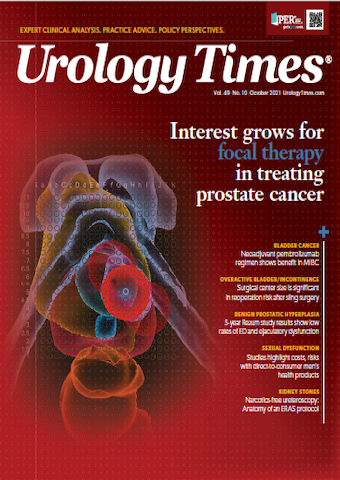Publication
Article
Urology Times Journal
Prostate cancer and CV risk: The heart of the matter
Author(s):
"Perhaps there is another Nobel Prize waiting to be had if we could reduce the cardiovascular effect of ADT and unlock the answer to the controversy surrounding the comparative safety and impact on cardiovascular health between GnRH agonists and antagonists," writes Michael S. Cookson, MD, MMHC.

Cookson, professor and chair of urology at the University of Oklahoma College of Medicine, Oklahoma City, is coeditor in chief for Urology Times®.
Unquestionably, the mainstay of therapy for men with advanced and metastatic prostate cancer is androgen deprivation therapy (ADT). The beneficial effect of ADT on controlling prostate cancer has been evident for more than 70 years following the pioneering work of Huggins and Hodges.1 Atherosclerotic cardiovascular disease (ASCVD) is the leading cause of noncancer death in men with prostate cancer, and many men with advanced prostate cancer harbor cardiovascular risk factors.2 Although the benefits of ADT are not disputed and the risk of ASCVD is acknowledged, there is controversy surrounding the relative cardiovascular safety of gonadotropin-releasing hormone (GnRH) antagonists compared with the GnRH agonists in men with prostate cancer and ASCVD treated with these agents.
To highlight this controversy, 2 important clinical trials recently published are worthy of mention. In the PRONOUNCE trial (NCT02663908), an international multicenter prospective study, men with prostate cancer and ASCVD were randomized to receive the GnRH antagonist degarelix or the GnRH agonist leuprolide for 12 months.3 The primary outcome was the time to first major adverse cardiovascular event (MACE). The study was terminated early because of the slower than projected enrollment and fewer than anticipated primary outcome events. Overall, there was no difference in MACE at 1 year between patients assigned to degarelix and those who received leuprolide (5.5% vs 4.1%, respectively; P = .534). The authors concluded that the relative cardiovascular safety of GnRH antagonists and agonists remains unresolved.
In contrast, in the phase 3 HERO study (NCT03085095), patients with advanced prostate cancer were randomly assigned in a 2:1 ratio to receive relugolix (Orgovyx), an oral GnRH antagonist, or leuprolide for 48 weeks.4 The primary end point was sustained testosterone suppression to castrate levels through 48 weeks, and the study met this end point. Of men who received relugolix, 96.7% maintained castration through 48 weeks compared with 88.8% of men receiving leuprolide. Among all patients, incidence of MACE was 2.9% in the relugolix group and 6.2% in the leuprolide group. The authors concluded that relugolix achieved rapid, sustained suppression of testosterone levels that was superior to that with leuprolide, with a 54% lower risk of MACE.
So what explains the difference between these 2 studies? One possibility is that the theoretical differences in safety between these agents is not as clinically meaningful in routine practice. There could also be differences in injectable vs oral GnRH antagonists. Another possibility is that in the PRONOUNCE study, in which the patients had known cardiovascular risk factors, cardiovascular events might have been lower because of better awareness and attention to cardiovascular risk control. In contrast, although patients who experienced MACE within 6 months before trial initiation were excluded in the HERO trial, presumably routine cardiovascular risk control would not have been so closely scrutinized. At a minimum, better attention to the cardiovascular risk factors among men with advanced prostate cancer, including those treated with ADT, will improve outcomes and reduce MACE. And perhaps there is another Nobel Prize waiting to be had if we could reduce the cardiovascular effect of ADT and unlock the answer to the controversy surrounding the comparative safety and impact on cardiovascular health between GnRH agonists and antagonists.
References
1. Corbin NS, Thompson I. Urology and the Nobel Prize. Urol Oncol. 2003;21(1):83–85. doi:10.1016/s1078-1439(03)00002-4
2. Leong DP, Fradet V, Shayegan B, et al. Cardiovascular risk in men with prostate cancer: insights from the RADICAL PC Study. J Urol. 2020;203(6):1109-1116. doi:10.1097/JU.0000000000000714
3. Lopes RD, Higano CS, Slovin SF, et al. Cardiovascular safety of degarelix versus leuprolide in patients with prostate cancer: the primary results of the PRONOUNCE randomized trial. Circulation. Published online August 30, 2021. doi:10.1161/circulationaha.121.056810
4. Shore ND, Saad F, Cookson MS, et al. Oral relugolix for androgen-deprivation therapy in advanced prostate cancer. New Engl J Med. 2020;382(23):2187-2196. doi:10.1056/NEJMoa2004325




















